Signatories of the Banco de Durango
The following signatories have been identified.
Cajero
|
He signed notes dated from 1891 to 1893. |
 |
|
Egberto Rapp Von Petersdorff was born in 1867, in Bremen, Germany as the son of Felix Rapp and Jenney Von Petersdorff. He married Maria Lozoya Loya from Guanaceví on 12 October 1898. He was appointed Cajero on 1 July 1893Semana Mercantil, 2a Epoca, Año IX, Núm. 28, 10 July 1893. He died on 14 September 1944, in Mexico City, Mexico, at the age of 77. He signed notes dated 1903. |
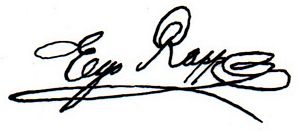 |
|
He signed notes dated 1903. |
 |
|
Manuel de Urquidi served for many years as manager of the Banco de Durango. In 1933, when Abelardo L. Rodríguez founded the Banco Mexicano, he chose Epigmenio Ibarra, who had been sub-director of the Banco de México, as director. So de Urquidi was appointed deputy director in Ibarra's place. Apparently the position was meant for someone of the same name, with many connections in political circles, but, due to an error, the appointment was mistakenly sent to this de Urquidi. Once this mistake was made, the authorities could no longer back down and de Urquidi was confirmed in his post. He signed notes dated from 1906 to 1910. |
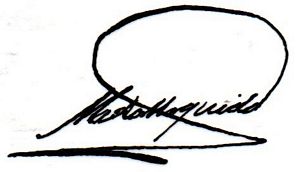 |
|
Heliodoro Dueñes del Palacio was born on 3 July 1877 in the city of Durango. In 1945 he wrote a book Los bancos y la revolución. He signed notes dated from 1913 to 1914. |
 |
Interventor
|
Luis N. Caravantes was born in 1848. He was nominated as the first InterventorLa Vanguardia, Año IV, 2a Epoca, Núm. 71, 23 April 1891 and signed the notes dated 1891 and 1892. He died in April 1893CEHM Fondo DLI-1 Copiadores del General Bernardo Reyes (1889-1911), 1.8.5315. |
 |
|
Francisco Gómez Palacio Tebar was the son of Francisco Gómez Palacio Bravo, a writer, educator, jurist and Liberal politician who twice served as governor of Durango. He was born in Durango on 2 April 1853. He was secretary of the Mexican legation in Washington and resided in the American capital from 1868 to 1873. The journey from his ranch in Durango to the city of Washington occupied three months. “We went overland in an old wagon, from San Lorenzo to Indianola, and there we were unsuccessful in finding a schooner. We continued our drive then up the beach to Corpus Christi, where we took an old schooner to Galveston. From there we sailed to New Orleans, and finished the trip by rail”The Mexican Herald, Vol. IX, No. 14, 14 September 1899. Gómez Palacio became one of the wealthiest hacendados in the state of Durango, owning the San Lorenzo hacienda. By 1899 he was building a magnificent stone mansion on the American plan, which, when completed, would be “one of the handsomest residences in the Republic”ibid.. In 1908 he was president and manager (gerente) of the Compañía Harinera de Durango with two mills at Porvenir, in the city of Durango, and at OleaEl Tiempo Ilustrado, Año VIII, No. 22, 31 May 1908. He was Interventor by 1906. He left office in April 1912, to be replaced by Carlos PatoniEl Criterio, 19 April 1912. In 1913 he joined other elderly “capitalists” in the Cuerpo de los Inválidos, one of the units formed for the defence of Durango against the rebelsEl Independiente, Año I, Núm. 127. 28 June 1913. He died in Mexico City on 18 October 1924. He signed the notes dated from 1893 to 1910. |
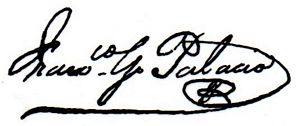 |
|
Gustavo Sáens de Sicilia He signed the notes issued during the revolution, in 1913 and 1914. |
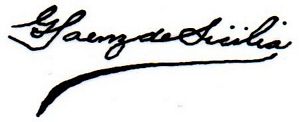 |
Consejero
|
On 1 July 1889 Carlos, in partnership with his brothers Ignacio and Julio, founded Bracho Hermanos for "commerce, industry and agriculture" The company undertook different investments, mainly in Durango, but the brothers' individual investments and management would highlight their particular business skills, not only in the state but outside. Their individual action would be accentuated in 1900 when the society was dissolved. Carlos would be particularly attracted by banking activities so that, as well as the Banco de Durango he was a member of the Board of Directors of the Banco Central Mexicano, a partner of the Banco Minero de Chihuahua and a shareholder of the Banco Mercantil de Monterrey. Apart from his investments in Durango in the mining and industry, at the beginning of the twentieth century Carlos Bracho would join as a partner of the Industrial Jabonera de La Laguna in which his brothers Julio, Rafael and Ignacio joined; with Julio and Ignacio he was also part of the business Cementos Hidalgo. The firm also owned the San Miguel de La Ochoa and La Labor de Guadalupe haciendas. Carlos Bracho was on the board from [ ] and presidente in 1906. He signed notes dated from 1891 to 1907. |
 |
|
Though José Maximiliano Damm’s father, Maximiliano Damm, was a founding member of the Banco de Durango a comparison of the signature on a 1893 $5 noteCMBanixo #37354 with later notes shows that all the notes were signed by José Maximiliano Damm. José (Joseph) Maximiliano Damm y Palacio was born in Durango on 21 December 1863, the son of Meximiliano Damm and María Josefa Palacio. In 1892 both he and his father, along with all the other leading men in Durango were members of the Club Porfirista Durangueño, to promote Porfirio Díaz’ re-election campaignEl Patria, Año XVI, Núm. 4,542, 20 February, 1892. In 1900 José was Secretario of the bank’s Consejo de AdministraciónLa Gazeta Comercial, Año I, Núm. 106, 8 February 1900. He signed notes dated from 1892 to 1907. |
 |
|
Antonio de Juambelz y Redo, a wealthy Spanish merchant, was with his brothers Joaquín, Angel and Sotero part, since its formation in 1883, of the firm Juambelz Hnos., created "for sale of clothes and groceries." Antonio was appointed head of the agency of the Banco Mercantil Mexicano when it tried to open in Durango in 1882; vice-consul of Spain in Durango and a partner of the wool and cotton factory La Confianza, located in Mapimí, (acquired in 1898, developed in 1903 with a group of northern businessmen - Juambelz Hermanos, Zubiría Hermanos. Miguel Torres, Antonia Franco de Arana, Javier Icaza for himself and on behalf of the Banco Nacional de México, Banco Occidental de México, Banco Mercantil de Monterrey and Banco de Nuevo LeónPeriódico Oficial, 18 December 1902. His company ran a renowned store called “Las Tres Rosas” situated on the southeast corner of avenida 5 de Febrero and calle Juárez. Antonio de Juambelz married Luz Bracho. One of their sons founded the newspaper El Siglo de Torreón on 8 March 1922. He signed notes dated from 1891 to 1901. |
 |
|
Angel excelled as an investor, becoming one of Mexico's wealthiest businessmen. He associated with relatives and friends in various companies including the Compañía Durangueña de Tabacos, S. A., manufacturer and distributor of cigars;. the Compañía Harinera de Durango, S. A. and the Compañía Maderera de la Sierra de Durango, S. A., which supplied sleepers to the railroad companies in the first two decades of the 20th centuryOthers included La Luz, S. A., established in Durango to manufacture candles, etc. and La Unión, S. A., a leather tannery and footwear factory in Gómez Palacio. Angel was also a shareholder of the Compañía Petrolera Orillas del Pánuco, S. A., in Tampico, Tamaulipas, and the Compañía Bancaria de Obras y Bienes Raíces, S. A (later Compañía Bancaria de Fomento y Bienes Raíces de México, S. A. With his brother Joaquin López Negrete he was associated in several companies like the mining company Angustias Dolores y Anexas in the town of Pozos, Guanajuato, and the coal company La Agujita in Ciudad Porfirio Díaz. Moreover, Angel was representative in the United States for the Colonia de la Condesa, an important land development company in Mexico City.. His and other branches of the family were regarded as enemies of the revolution, so some of their properties were intervened: for Angel the Compañía Petrolera Orillas del Pánuco and the hacienda of San Carlos, in the state of Durango, and in 1916 Carranza tried unsuccessfully to confiscate the Hacienda El Prieto, located in the Estado de México. He signed notes dated from 1903 to 1914. |
  |
|
José Saracho was a Spanish businessmen who owned the hotel "El Progreso". He signed notes dated from 1906 to 1907. |
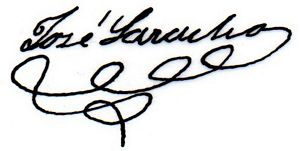 |
|
Jesús Leonardo Asúnsolo Jaques was the bank's contador in 1899 and cajero from February 1909El Tiempo, Año XXVI, Núm. 8492, 18 February 1909. Jesús Asúnsolo married Antonia López-Negrete and was the father of the actress Dolores del RíoMaría de los Dolores Asúnsolo y López-Negrete was born in Durango on 3 August 1904. In 1919, a then 15-year-old Dolores saw a performance of the Russian ballerina Anna Pavlova, whose interpretation influenced her to become a dancer and she took dance lessons with the respected teacher Felipita Lopez. In 1921, aged 17, Dolores was invited by a group of Mexican women to dance in a party to benefit a local hospital. At this party, she met Jaime Martínez del Río y Viñent, son of a wealthy family. After a two-month courtship, the couple wed on 11 April 1921 and honeymooned in Europe for two years. They returned to Mexico in 1924 and decided to live on Jaime's ranch in Durango, where cotton was the main crop but after the cotton market suffered a precipitous fall, they were on the verge of ruin and decided to settle in Mexico City. There, in early 1925, Dolores met the American filmmaker Edwin Carewe, who invited the couple to work in Hollywood. She had roles on a string of successful films during the American "silent" era and with the advent of sound acted in a range of film genres, from contemporary crime melodramas to musical comedies and romantic dramas. In the early 1940s, when her Hollywood career began to decline, Del Río returned to Mexico and joined the Mexican film industry, which at that time was at its peak and became one of the more important stars of the Golden Age of Mexican cinema. A series of Mexican films starring Del Rio, are considered classic masterpieces and helped boost Mexican cinema worldwide. She remained active mainly in Mexican films throughout the 1950s and in 1960 returned to Hollywood. During the next years she appeared in Mexican and American films. From the late 1950s until the early 1970s she also successfully ventured into theatre in Mexico and appeared in some American TV series. When the rebels attacked Durango Asúnsolo decided to escape to the United States, while his wife and daughter fled to Mexico City in a train, disguised as peasants. In 1912, the Asúnsolo family reunited in Mexico City and lived under the protection of then president Francisco I. Madero, who was a cousin of Antonia. He signed $50 notes dated 18 June 1913 and $20 notes dated 1 March 1914. |
 |
|
Francisco de P. Salcido He signed notes dated 1906 and 1907. |
 |
|
Miguel Zubiría He signed notes dated 1910. |
 |
|
Eduardo Hartman was also involved in the Compañía Madera de la Sierra de Durango, S. A., which supplied sleepers to the railroad companies in the first two decades of the 20th century. He was a consejero propietario in 1908 and signed notes dated 1910 to 1914. |
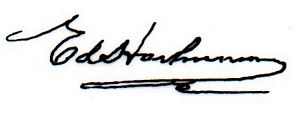 |
|
Ignacio Fernández é Imas was Secretario of the Asociación de Durangueños in 1908. He signed notes dated 1913 and 1914. |
 |
|
Rodolfo Veyán Natera was born c. 1881, the son of Luciano Veyán Lapelouse, who in turn was the son of French immigrants who first set up as silk merchants in Veracruz and then moved north during the French Intervention. On 26 December 1877 Luciano and his wife, Juana Natera del Fierro, bought the hacienda de San Mateo de la Zarca for $28,000. The end of the Indian wars and suppression of banditry during the Porfiriato allowed Veyán to become one of the greatest and richest landholders in the state through acquiring the haciendas of San Lorenzo del Casco, San Juan Bautista de Cerro Gordo and Antonio del Paso del Pinole. In 1905 Luciano left his estates to his sons, and Rodolfo inherited the hacienda de la Zarca. He died in Coahuila in 1968. He signed notes dated 1913 and 1914. |
 |

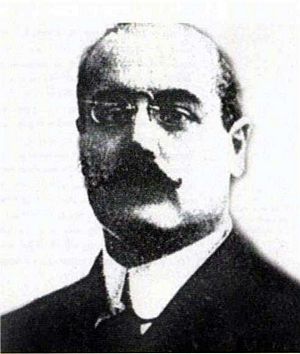
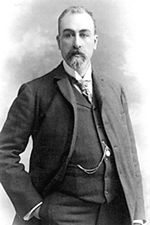
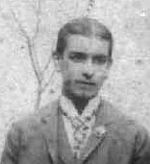 Angel López Negrete was born in 1874, of a wealthy Duranguense family that owned the hacienda Sombreretillos de Campa. In 1905 Angel’s mother, who had inherited Sombreretillos, rented it to her sons, Laureano and Angel, who formed the Sociedad López Negrete Hermanos to manage the livestock and production of mezcal.
Angel López Negrete was born in 1874, of a wealthy Duranguense family that owned the hacienda Sombreretillos de Campa. In 1905 Angel’s mother, who had inherited Sombreretillos, rented it to her sons, Laureano and Angel, who formed the Sociedad López Negrete Hermanos to manage the livestock and production of mezcal.